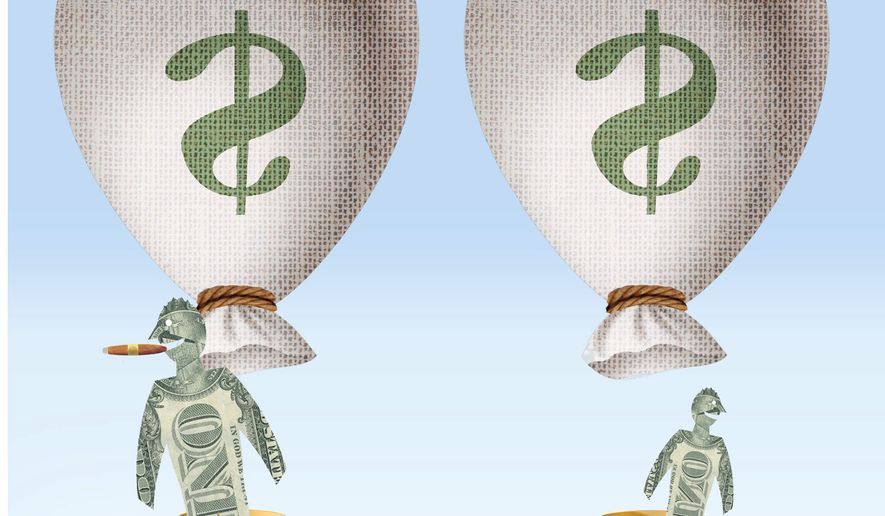OPINION:
Despite liberal hysterics, Republicans’ recent tax cut raised top earners’ share of America’s tax burden. This seemingly “squared circle” is simply due to a fact true before the legislation and even truer after: Middle- and upper-income earners shoulder the overwhelming tax load. Equally obvious: Even so large a share is not enough for an insatiable left.
Liberals’ accusation throughout the tax cut debate has been that it is a giveaway to the wealthy at everyone else’s expense. It is Occupy Wall Street recast — the 1 percent over the 99. Fortunately, there is a straightforward test to verify this: The wealthy’s share of the tax burden should be lower.
This is clearly the proper criterion because simply counting tax dollars saved will not suffice. The larger the tax bill, the bigger the cut. This applies when rates are cut by the same percentage. It can also occur even when top rates are cut by a smaller percentage than lower rates are.
Consider one taxpayer earning $1,000 and another earning $100. If both are taxed at 20 percent rates and both rates are cut in half to 10 percent, the first taxpayer saves $100 and the second $10. A big absolute difference exists despite rates falling equally.
Even if the top rate payer’s taxes are cut by half the percentage of the second — say, 5 percentage points versus 10 — a clear absolute difference results. The first taxpayer saves $50 versus the second taxpayer’s $10 savings — despite the second taxpayer seeing his percentage rate cut being twice the higher earner’s.
Somehow, this obvious fact escapes the left. Or more accurately, the left seeks to escape this obvious fact. Their argument against the tax cut rests entirely on their subjective use of absolute dollars versus the objective necessity of comparing the change in overall tax burden.
According to the Joint Committee on Taxation, Congress’ nonpartisan revenue estimator, in 2017 before the tax cut, those earning $1 million or more paid 19.5 percent of America’s income, employment and excise taxes. After the tax cut in 2018, those earners will pay 20.4 percent.
The same tax burden increases occurred for those earning $500,000 to $1 million and for those making $200,000 to $500,000. Those making $200,000 and above paid 49.8 percent of all income, employment and excise taxes before the tax cut. After the tax cut, they are projected to pay 51.3 percent.
It was when descending to the income bracket of $100,000 to $200,000 — hardly “the rich” — that earners saw their share of the tax burden fall — but even then, only minutely: From 29 percent in 2017 to 28.8 percent in 2018.
By the objective test of who shoulders the tax burden and whether it rose or fell, Republicans’ tax cut is hardly the rich’s windfall that liberals claim. Following liberals’ logic of weighing the value of the tax cut by counting the absolute distribution of dollars, even entirely eliminating lower earners’ tax burden would still not be “fair,” because their savings would still be less than higher earners’.
If that seems an impossibility, consider America’s tax burden reality. In 2017, those making $50,000 or more paid 95.6 percent of income, employment and excise taxes. In 2018, they are projected to pay 96.2 percent. Yet, those below these levels will still be treated “unfairly” by liberal logic, despite their share of America’s tax burden falling from 4.4 percent to 3.8 percent — a 14 percent drop compared to those above, the highest of whose tax bill actually increased.
Equally important to unraveling liberals’ inaccurate claims is unmasking why they are so intent on making them.
Certainly, this is part of a broader effort to discredit President Trump and Republicans in general. Their policies are not liberal, and nothing stands further from the left than cutting taxes.
Big taxes are needed to fund big government. When it comes to both, there is never “enough” for the left-wingers. For them, government can always do more and the private sector should always pay more. So a policy of reducing rates takes them further from both.
It is also especially threatening now. With the economy finally rebounding after eight long underperforming years, the left’s fear is that Barack Obama’s economic record will be seen for what it actually was. Additionally, they dread Americans will not just connect their Obama-era policies with economic malaise, but also quintessentially conservative tax cuts with today’s rebound.
Liberals’ only recourse is to deploy unreal arguments — such as upper earners’ growing share of the tax burden somehow hurting earners whose burden is falling.
• J.T. Young served under President George W. Bush as the director of communications in the Office of Management and Budget and as deputy assistant secretary of the Treasury.




Please read our comment policy before commenting.